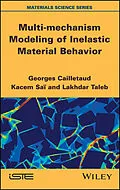This book focuses on a particular class of models (namely Multi-Mechanism models) and their applications to extensive experimental data base related to different kind of materials. These models (i) are able to describe the main mechanical effects in plasticity, creep, creep/plasticity interaction, ratcheting extra-hardening under non-proportional loading (ii) provide local information (such us local stress/strain fields, damage, ....). A particular attention is paid to the identification process of material parameters. Moreover, finite element implementation of the Multi-Mechanism models is detailed.
Autorentext
Georges CAILLETAUD, MINES ParisTech, FranceLakhdar TALEB, INSA Rouen, FranceKacem SAI, ENIS Sfax, France
Inhalt
Preface xi
Introduction xiii
Chapter 1. State of the Art 1
1.1. Motivation from the microstructure 1
1.2. Building bricks 6
1.2.1. Criteria 7
1.2.2. Isotropic hardening rules 12
1.2.3. Kinematic hardening rules (KHR) 17
1.2.4. Plastic modulus 19
1.2.5. Viscosity 24
1.3. Scale transition rules 27
1.3.1. General remarks on scale transition rules 27
1.3.2. Scale transition rules for the MM model 29
1.4. Large deformation 30
1.5. Brief history of the MM models 32
Chapter 2. Model Formulation 35
2.1. Thermodynamic framework 35
2.2. Model with various mechanisms and various criteria: the 2M2C model 37
2.3. Model with various mechanisms and one criterion: the 2M1C model 39
2.4. Comparison with the unified model 40
2.5. Isotropic hardening rules 41
2.5.1. Isotropic hardening for models with various mechanisms and one criterion 41
2.5.2. Isotropic hardening for models with various mechanisms and various criteria 43
2.6. Kinematic hardening rules 45
2.6.1. KHR: models with various mechanisms and various criteria 45
2.6.2. KHR: models with various mechanisms and one criterion 46
2.7. Computation of the inelastic multipliers 46
2.7.1. Flow rate for the 2M1C model 47
2.7.2. Flow rates for the 2M2C model 47
Chapter 3. Typical MM Responses 51
3.1. Some MM model variants 51
3.1.1. Initial MM models 51
3.1.2. Updated 2M1C models after [TAL 06] 53
3.1.3. Updated MM models after [SAÏ 07] 53
3.1.4. A general nMnC model 54
3.1.5. Generalization of the 2M1C model 56
3.2. Creepplasticity interaction 56
3.3. Rate sensitivity for the 2M2C model 58
3.4. Stabilized behavior of viscoplastic 2M1C model 59
3.5. Closed-form solution for ratcheting behavior of the 2M2C model: case of linear kinematic hardening rules 60
3.6. Ratcheting for 2M1C model 64
3.7. Ratcheting behavior of the 10M10C model 67
3.8. Extra-hardening under non-proportional loading 69
3.9. Static recovery effect 72
Chapter 4. Comparison with Experimental Databases 77
4.1. Inconel 718 79
4.1.1. Context of the case study 79
4.1.2. Particular model features 79
4.1.3. Numerical results 79
4.2. Deformation mechanisms of NiTi shape memory alloy 80
4.2.1. Context of the case study 80
4.2.2. Particular model features 82
4.2.3. Numerical results 82
4.3. N18 alloy 83
4.3.1. Context of the case study 83
4.3.2. Particular model features 84
4.3.3. Numerical results 85
4.4. Carbon steel CS1026 87
4.4.1. Context of the case study 87
4.4.2. Particular model features 87
4.4.3. Numerical results 88
4.5. Thermo-mechanical behavior of 55NiCrMoV7 89
4.5.1. Context of the case study 89
4.5.2. Particular model features 90
4.5.3. Numerical results 91
4.6. 2017 Aluminum alloy 94
4.6.1. 2017A, [SAÏ 12] 94
4.6.2. 2017A, [TAL 15] 97
4.7. 304 austenitic stainless steel 101
4.7.1. 304SS at room temperature [HAS 08] 101
4.7.2. 304SS at room temperature [TAL 11] 102
4.7.3. 304SS at 350C [TAL 14] 105
4.7.4. 304SS at room temperature [HAS 94a], 2M1C-3M1C 107
4.7.5. 304SS at room temperature [HAS 08, TAL 10], 2M1C-3M1C 112
4.8. 316 austenitic stainless steel 116
4.8.1. 316SS at room temperature [POR 00] 116
4.8.2. 316SS at room temperature [TAL 15] 119
4.8.3. 316SS at 350C [TAL 13b, TAL 14] 121
4.8.4. 316SS at room temperature [POR 00], 3M1C model 123
4.9. Recrystallized Zirconium alloy 4 [PRI 08] 124
4.9.1. Context of the case study 124
4.9.2. Particular mode...
